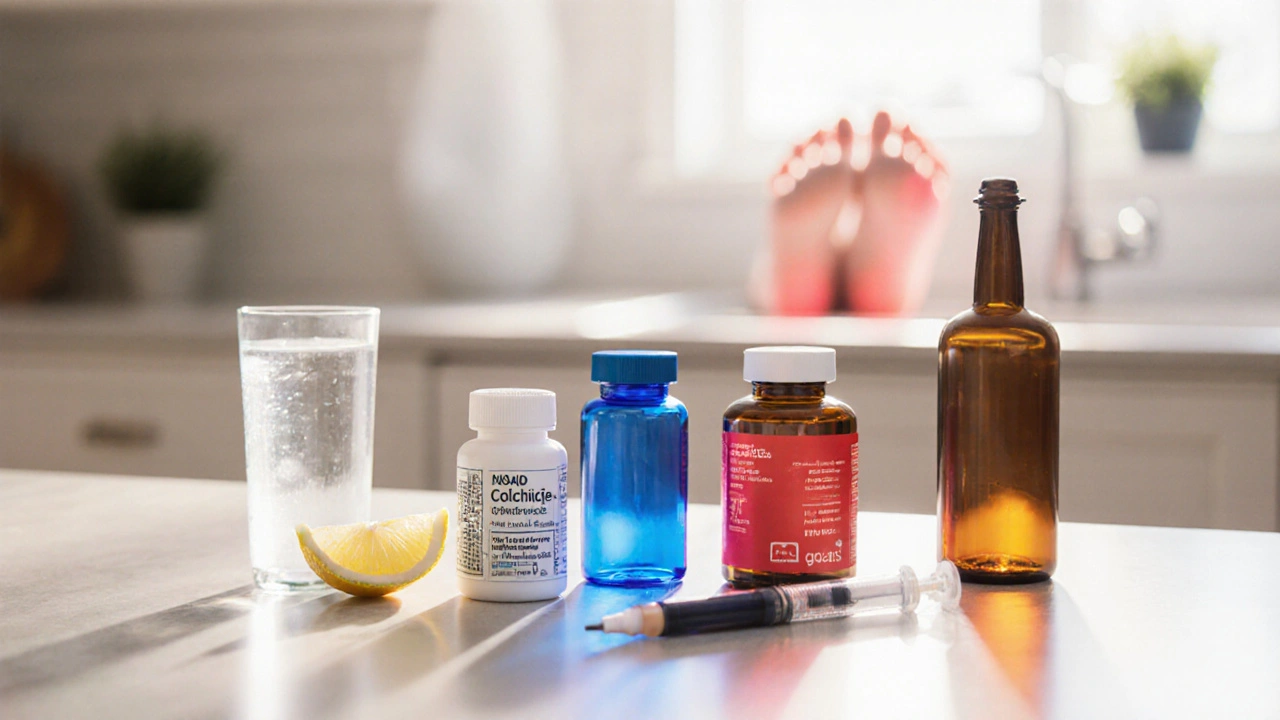Colchicine vs Alternatives: Which Gout Treatment Works Best?

Gout Treatment Selector
Assess Your Situation
Quick Take
- Colchicine blocks neutrophil activity and is fast‑acting for acute gout.
- NSAIDs provide strong pain relief but can hurt stomach and kidneys.
- Corticosteroids work well when NSAIDs are unsafe, yet they raise blood sugar.
- IL‑1 inhibitors target the inflammatory pathway but are costly and injected.
- Allopurinol and febuxostat lower uric‑acid production for long‑term flare prevention.
When treating acute gout, Colchicine is a plant‑derived alkaloid that reduces inflammation by inhibiting neutrophil migration. It’s been the go‑to drug for centuries, but modern therapy offers many other routes. This article walks you through how colchicine stacks up against the most common alternatives, when each is appropriate, and what side‑effects to watch out for.
What Is Colchicine?
Colchicine originates from the autumn crocus (Colchicum autumnale) and has been used for gout since the ancient Greeks. Its primary job is to halt the inflammatory cascade that follows uric‑acid crystal deposition.
Mechanistically, colchicine binds to tubulin, preventing microtubule polymerization. This stops neutrophils from moving to the crystal site, which in turn reduces swelling and pain. Because it works at the cellular level rather than masking pain, it can be effective even when NSAIDs fail.
When Do Doctors Choose Colchicine?
Colchicine shines in three scenarios:
- Early acute attacks - taken within 12hours of symptom onset, it can shorten the flare by up to 50%.
- Patients who can’t tolerate NSAIDs due to ulcers, kidney disease, or heart failure.
- When a quick, oral option is needed and injections are impractical.
The usual dosing is 1.2mg (one tablet) followed by 0.6mg one hour later for the first attack, then 0.6mg once or twice daily for prophylaxis. Dose adjustments are crucial for people with renal or hepatic impairment because the drug is cleared through both pathways.
Alternatives at a Glance
Here’s a snapshot of the main substitutes doctors consider:
- NSAIDs (e.g., indomethacin, naproxen) - block cyclo‑oxygenase, lowering prostaglandins.
- Corticosteroids (e.g., prednisone) - suppress a broad range of immune signals.
- IL‑1 inhibitors (e.g., canakinumab, anakinra) - neutralize interleukin‑1, the key driver of gout inflammation.
- Allopurinol - xanthine oxidase inhibitor that reduces uric‑acid production for long‑term control.
- Febuxostat - newer xanthine oxidase inhibitor for patients who can’t tolerate allopurinol.
- Lifestyle modifications - diet, hydration, weight loss, and alcohol reduction to lower uric‑acid levels.

Side‑Effect Profile Comparison
| Drug | Mechanism | Onset (hrs) | Main Side‑Effects | Typical Contra‑indications |
|---|---|---|---|---|
| Colchicine | Inhibits microtubule polymerization | 1-2 | GI upset, diarrhea, rare myopathy | Severe renal/hepatic failure, drug interactions (e.g., macrolides) |
| NSAIDs | COX inhibition → ↓ prostaglandins | 0.5-1 | Stomach ulcer, renal impairment, cardiovascular risk | Active ulcer disease, CHF, CKD stage4+ |
| Corticosteroids | Broad immune suppression via glucocorticoid receptors | 2-4 | Hyperglycemia, mood changes, osteoporosis | Uncontrolled diabetes, active infection, severe psychiatric illness |
| IL‑1 inhibitors | Neutralizes interleukin‑1β | 4-6 (injection) | Injection site reaction, increased infection risk | Active severe infection, immunosuppressed status |
| Allopurinol | Xanthine oxidase inhibition → ↓ uric‑acid synthesis | Days-weeks (for serum urate lowering) | Rash, hypersensitivity, rare liver toxicity | Severe renal failure without dose adjustment |
| Febuxostat | Selective xanthine oxidase inhibition | Days-weeks | Elevated liver enzymes, cardiovascular events | Severe hepatic disease, recent CV event |
Pros and Cons in Real‑World Use
Colchicine is cheap and oral, but the GI side‑effects can be a deal‑breaker if the dose isn’t titrated. It’s also notorious for dangerous drug interactions - a single macrolide antibiotic can push colchicine levels to toxic ranges.
NSAIDs provide rapid pain relief and are familiar to most patients. However, anyone with a history of ulcer disease or chronic kidney disease should avoid them unless protected with a proton‑pump inhibitor.
Corticosteroids are versatile - they work for gout and many other inflammatory conditions. The catch is the systemic load; short bursts are generally safe, but long‑term use raises bone loss and blood‑sugar concerns.
IL‑1 inhibitors are the most targeted option and can calm even the most stubborn flares. The downside is price - a single injection can cost several hundred pounds - and they require a healthcare professional for administration.
For chronic management, Allopurinol and Febuxostat lower uric‑acid production, meaning fewer future attacks. They don’t help an acute flare, so they’re usually combined with colchicine or NSAIDs for the first few weeks.
How to Choose the Right Option for You
Think of the decision tree as three questions:
- Is the flare already raging? - Pick a fast‑acting oral drug (colchicine or NSAID).
- Do you have kidney, stomach, or heart limits? - Skip NSAIDs if you have CKD or ulcer risk; choose colchicine or a low‑dose steroid.
- Is long‑term uric‑acid control needed? - Add allopurinol or febuxostat and keep a low‑dose colchicine for prophylaxis.
Always discuss dosage adjustments with your GP, especially if you’re over 65, have liver disease, or take statins - the combination can raise the risk of muscle damage.
Practical Tips and Pitfalls
- Start colchicine early. The sooner you take it, the more it trims the flare.
- Hydrate - drinking at least 2L of water a day helps flush uric acid.
- Avoid high‑purine foods (red meat, organ meats, certain seafood) during an attack.
- Check your meds. If you’re on clarithromycin, ciprofloxacin, or certain antifungals, tell your doctor before starting colchicine.
- Monitor kidney function. Blood tests every 3-6months are wise if you stay on colchicine long term.
Frequently Asked Questions
Can I use colchicine and NSAIDs together?
Yes, a short overlap can be OK for severe pain, but keep the NSAID dose low and watch for stomach upset. Always ask a clinician before combining.
What makes IL‑1 inhibitors so expensive?
They’re biologic agents produced through complex cell‑culture processes, requiring stringent storage and administration. That drives the high price tag.
Is colchicine safe during pregnancy?
Colchicine is listed as Category D, meaning it should only be used if the benefits outweigh the risks. Most doctors avoid it unless gout is severe and other drugs are unsuitable.
How long does it take for allopurinol to lower uric‑acid levels?
Typical serum urate reduction appears after 2-4weeks, with maximal effect around 6months. Patience is key; continue the medication even if flares still occur early on.
What lifestyle changes boost the effectiveness of gout meds?
Weight loss, limiting alcohol (especially beer), staying hydrated, and eating low‑purine foods can lower uric‑acid production, letting lower drug doses work better.
lucy kindseth
September 29, 2025 AT 17:10When you’re dealing with an acute gout flare, the timing of colchicine matters a lot. If you can start within the first 12 hours, you’ll usually see the pain and swelling drop dramatically. Make sure to adjust the dose if you have any kidney issues – the standard 1.2 mg then 0.6 mg can become risky. Also, keep an eye on drug interactions; many antibiotics and statins can bump colchicine levels up. Hydration is key – sipping water throughout the day helps flush out uric acid and reduces the chance of another flare.
Karen McCormack
October 5, 2025 AT 13:26In the grand theater of human physiology, gout emerges as a tragic playwright, casting uric‑acid crystals as the villainous protagonists. Colchicine strides onto the stage, a humble herb‑derived hero, halting neutrophils with a whisper of microtubule disruption. Yet, the narrative does not end there; NSAIDs thunder onto the scene, delivering swift relief but at the cost of gastric citadels and renal bastions. Corticosteroids enter, draped in a cloak of broad immunosuppression, whispering promises of control while flirting with blood‑sugar storms. The modern saga introduces IL‑1 inhibitors, glittering biotechnological knights, whose price tag echoes the opulence of royal courts. Meanwhile, Allopurinol and Febuxostat plot a slower, methodical conquest, lowering the very source of the crystalline antagonists. When choosing a champion, one must weigh the urgency of the flare against the long‑term kingdom of kidney health, gastrointestinal stability, and cardiovascular fortitude. A patient with a history of ulcers may find solace in colchicine’s oral simplicity, provided the dose is tempered. Conversely, a soul besieged by heart failure might seek the gentle embrace of low‑dose steroids, albeit briefly. The art of gout management is thus a chiaroscuro of rapid relief and prophylactic stewardship, each brushstroke guided by comorbidities and lifestyle. Hydration, diet, and weight management ink the background, subtly yet powerfully influencing outcomes. In the end, the clinician’s wisdom lies in orchestrating these actors into a harmonious performance, where pain subsides, uric acid bows, and the patient enjoys a reprieve from the relentless drama of gout.
Earl Hutchins
October 5, 2025 AT 13:43Watch out for colchicine‑macrolide interactions.
Tony Bayard
October 11, 2025 AT 08:20If you feel that burning heat creeping up your big toe, you’re in the midst of an acute gout inferno. Time is of the essence; the earlier you pop a colchicine dose, the more you tame that flaming cascade. Don’t let the fear of diarrhea hold you back – a modest dose split over a few hours often spares the gut. For those with a tender stomach, a low‑dose NSAID paired with a proton‑pump inhibitor can be a lifesaver. And remember, after the flare subsides, staying on a low‑dose colchicine for a few weeks can prevent the next surprise attack.
Jay Crowley
October 11, 2025 AT 08:28Split the loading dose; it reduces GI upset. Keep a glass of water handy.
sharon rider
October 17, 2025 AT 03:13Kidney function plays a starring role in deciding whether colchicine is safe. If your eGFR drops below 30 ml/min, the drug can linger and cause toxicity. In such cases, the clinician may favor a short course of low‑dose steroids or a carefully reduced colchicine regimen. Monitoring serum creatinine before and during therapy is prudent. Also, stay clear of concurrent nephrotoxic agents like NSAIDs, which could compound the risk.
swapnil gedam
October 22, 2025 AT 22:06IL‑1 inhibitors, such as anakinra, are like the elite special forces of gout treatment. They target the inflammatory cascade directly, offering relief when other drugs fail. The downside? Their price tag can rival a small vacation, and you need a healthcare professional to give the injection. They’re best reserved for refractory cases or patients who can’t tolerate colchicine, NSAIDs, or steroids.
Michael Vincenzi
October 22, 2025 AT 22:15Staying well‑hydrated is a simple yet powerful ally; aim for at least two liters of water daily. It helps flush uric acid and can blunt the severity of a flare. Pairing good hydration with a low‑purine diet maximizes the benefit.
steve wowiling
October 28, 2025 AT 17:00NSAIDs? Nah, they’re a migraine in a bottle.
Nancy Chen
November 3, 2025 AT 11:53Ever notice how the big pharma ads push allopurinol like it’s the ultimate cure, while the cheaper colchicine stays in the shadows? There’s a whole network of profit‑driven motives steering what we’re told is ‘best practice’. Keep your eyes open and ask for the full picture before you swallow a pill.
Susan Rose
November 9, 2025 AT 06:46Don’t underestimate the power of lifestyle tweaks – ditch the excess beer, lose a few pounds, and load up on cherries. Those simple moves can lower uric acid enough to let you down‑dose your meds, which is a win for both your wallet and your gut.